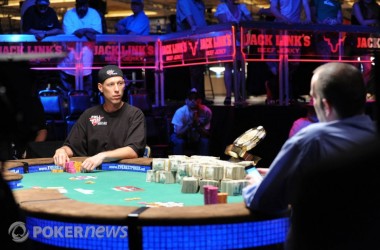PokerNews Debate: Is the WSOP Live Stream Good or Bad for Players?

The World Series of Poker is just a few short weeks away and every poker player will tell you that it's the best time of the year for action on the felt. To better capture that action for the fans at home, ESPN announced it will add 32 hours of additional WSOP coverage including live, unedited hole cards on a 30-minute delay. That sparked plenty of debate within the poker community as to whether or not this decision was good or bad for the players. PokerNews' Donnie Peters and Rich Ryan debate the topic.
Rich Ryan believes it’s good for the game.
Semi-live coverage of the 2011 WSOP Main Event will be great for the game because televised poker single-handedly drives the popularity of poker. If ESPN didn’t cover the WSOP when Chris Moneymaker won the Main Event, then there never would’ve been a poker boom, and I wouldn’t be writing this. In the wake of Black Friday, televised poker is going to change dramatically because fewer online sites are capable of hosting shows in the American market. Rather than follow suit and scale down their coverage of the WSOP, ESPN chose to expand it – which is crucial for the poker community.
Watching poker live on ESPN3 may be acceptable for die-hard fans, but the average viewer needs to see the hole cards. Thanks to the 30-minute delay, fans will be able to watch with hole cards and the players don’t have to be quarantined like they were at the PCA. Additionally, not everyone has access to ESPN3, whereas ESPN and ESPN2 are available on almost all basic cable packages. The diehards can still watch the action on a 5-minute delay without hole cards on ESPN3, but even they will probably switch to ESPN/ESPN2 once the semi-live feed kicks in.
The importance of semi-live coverage to the popularity of the game is greater than the perceived disadvantage facing the few players it will affect. Hole cards will only be shown postflop, and only on the two featured tables. For those against the semi-live stream, don't worry — your steals and re-steals will remain hidden. Plus, even if you go deep in the Main Event, you're not guaranteed to make a featured table. During the first few days of coverage, only a small percentage of the players will be at those two tables. Likewise, once the field dwindles to 18, everyone will have the same opportunity to data-mine, if you will. If you don't have enough friends to sweat the live-stream by that point, then I suggest you put some of your prize money to work.
Barry Greenstein openly supports the idea of semi-live coverage, and even voted to have the cards show preflop, but the Players Advisory Council would not pass the idea unless a post-flop compromise was made. Greenstein agrees that sometimes we have to make sacrifices in order to grow the game, especially when television is involved.
In the mid 2000s, Erik Seidel was vehemently against showing hole cards, even when shows aired months after the events took place. Initially, he hid his cards from the lipstick cameras for fear that people would learn the secrets of his game, but eventually he gave in. Now, in 2011 – with hours upon hours of footage available – Seidel is enjoying his greatest poker year ever. Only so much can be learned from a few televised hands, but there is an untapped wealth of new viewers ready to consume the game if the right product is procured.
Donnie Peters believes the players will suffer.
This debate is not whether the WSOP live streaming is good or bad for poker, but rather whether it is good or bad for the players. Even though more fans will be drawn in to view and this is a big, positive step for WSOP broadcasting, many players will be negatively affected, mainly amateurs.
If you're an amateur who happens to draw a seat at one of the feature tables, your hole cards will now be displayed to the world almost immediately. This is going to allow most if not all the professionals in the field to be able to record and review the play of amateurs day after day. From there, the pros can make the necessary adjustments for the following days whereas in the past, an advantage that an unknown amateur had on a pro was that the pro had no idea how the amateur played. To highlight this point, let's take a look at an example.
Back in 2006, Jamie Gold successfully maneuvered his way to a massive stack in the Main Event and a lot of his play was done with correctly timed table talk and well-executed bluffs. Most of the time with the WSOP, when the tournament goes deeper and deeper, the chip leader is often featured on one of the televised tables. That would've been Gold in this case and his hole cards would have been shown on a 30-minute delay to the world. Don't you think that if the pros had access to this information, they'd be able to adjust to Gold's antics and counteract him? They'd be able to pick up on things that only pros can when it comes to physical tells and verbal tells, which Gold had plenty of. What worked so well to Gold's advantage was that no one knew what he was doing the entire time. Sure, anyone can look back with hindsight vision, but that wasn't available then until the show aired weeks later.
What's to stop pros on a feature table with the chip leader from setting up a DVR in their trailers out back of the Rio to review the tapes from key hands on breaks? With two-hour levels and the live stream on a 30-minute delay, there would be plenty of time to check out a couple of key hands from the last level while on break and to make adjustments moving forward.
When it comes down to it, the pros should all be for this sort of live-streaming whereas the amateurs shouldn't. Pros will be able to make on-the-fly adjustments to counteract their opponents' plays and also to alter their own. Amateurs won't have the experience or knowledge to be able to do so and it makes the WSOP Main Event much less of a level playing field. It makes sense that players like Greenstein would advocate for this and he'll be able to adjust on the fly much more easily if he has access to his opponents' hole cards.
Over on the TwoPlusTwo Forums, Todd Terry gave his opinion on the matter. "I think showing hole cards while the tournament is going on with the ability to have that information used against you either later that day or on subsequent days should not be allowed," Terry said. "If I am at one of these tables I will block my hole card cam. I can't believe they will force players to be at a competitive disadvantage in the tournament they're playing for TV. And if that's the plan this needs to be stopped." If you'd like to read a little more about the back and forth on the TwoPlusTwo Forums, check out the thread.
Terry went on to tweet a bit about the topic and got a response from the WSOP. "@WSOP: @toddbterry November Niners had 4 months to pick each others play apart. What was the result? Players mix up their game, that's the beauty." What's wrong with this is that all WSOP November Niners had this opportunity, whereas only a few select players will be able to do so when focusing on the feature tables. Everyone not on a televised table won't have the opportunity to take advantage of knowing his or her opponents' hole cards. Jonathan Aguiar questioned the WSOP on this by saying, "@wsop you really don't understand the difference between a 30 minute delay and a 3 month one?" on Twitter.
In the end, unless it's a 100 percent level playing field all in the WSOP Main Event, it shouldn't be done. Only two televised tables will have the opportunity to take advantage of the 30-minute delayed live stream. The better players on those tables will thrive from this and the weaker players will be severely handicapped. The question is whether or not the decision to have a WSOP live stream from two televised tables is good for the players? The answer is no.
Remember, the PokerNews Live Reporting Team will once again be the official live reporting team for the 2011 World Series of Poker. We'll be bringing you coverage of all 58 events live from the Rio all summer.
What is your position on this topic? Use the comments section below to let us know what you think. In the meantime, be sure to follow us on Twitter and like us on Facebook.









